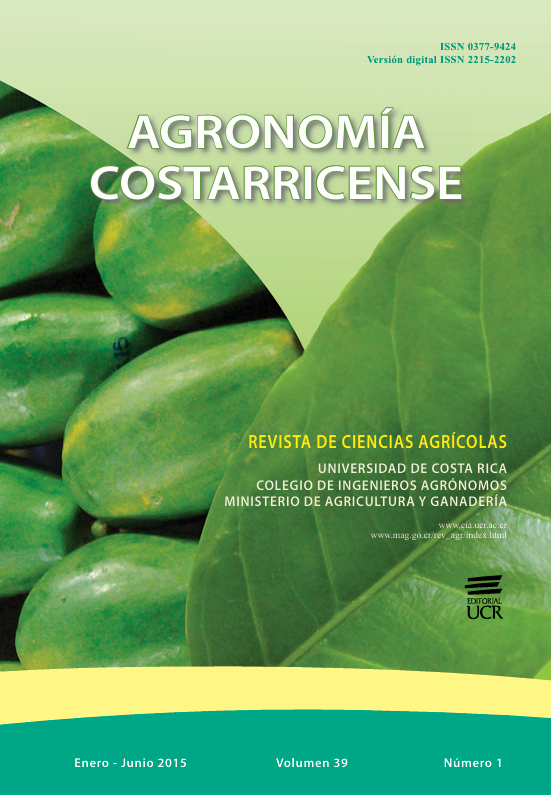Abstract
Maradol is the main papaya cultivated in Mexico and one of the main crops in Yucatan. It presents some inconveniences, such as susceptibility to viruses, so new cultivars that can surpass Maradol yield are looked for, but it is necessary that they show similar quality characteristics. The objective of this study was to evaluate the quality characteristics of the fruits of new genotypes produced in Yucatan. Six commercial materials (Maradol, Sensation, Intenzza, Siluet, Lenia Plus and Jibara) and 2 hybrids generated by INIFAP (Azteca and MSXJ) were evaluated. Size, color of peel and pulp, firmness of the pulp and total soluble solids content were assessed. In fruit size, except for Jibara which is very big (2.900 kg) and Siluet, which is very small (1.200 kg), the remaining 6 varieties were similar to Maradol. As for peel color, Intenzza and Siluet presented a similar hue than Maradol (65 a 67o), but more luminosity. Siluet and Sensation had more total soluble solids than Maradol, but less pulp firmness. Sensation, Lenia Plus and MSXJ show good characteristics considering fruit size, pulp firmness, total soluble solids content and peel and pulp color, thus can compete in quality with Maradol variety.References
ALONSO M., TORNET Y., ARANGUREN M., RAMO R., RODRÍGUEZ K., PASTOR M. 2008. Caracterización de los frutos de cuatro cultivares de papaya del grupo solo, introducidos en Cuba. Agronomía Costarricense 32(2):169-175.
DUCH G.J. 1988. La conformación territorial del Estado de Yucatán. Universidad Autónoma Chapingo. México.180 p. GIL A.I.,
MIRANDA D. 2005. Morfología de la flor y de la semilla de papaya (Carica papaya L.): variedad Maradol e híbrido Tainung-1. Agronomía Colombiana 23(2):217-222.
McGUIRE R.G. 1992. Reporting of objective color measurements. Hortscience 27(12):1254-1255.
MIRAFUENTES F., AZPEITIA M. 2008. Azteca, primer híbrido de papaya para el trópico de México. Revista Fitotecnia Mexicana 31(3):291-293.
MIRAFUENTES F., SANTAMARÍA F., AZPEITIA A. 2011, Características de un nuevo híbrido de papaya para el sur de México, pp 286-289. In: Memorias de la XXIII Reunión Científica Tecnológica Forestal y Agropecuaria Tabasco, noviembre 2011. Villahermosa, Tabasco, México.
PAPAYA SEED LEGON. 2013. Lenia Plus. Consultado en diciembre 2013. Disponible en http://www. papayaseedlegon.com.mx/index.html
POSADA P.L., GÓMEZ K.R., PÉREZ P.J., REYES V.M., NORMAN M.O. 2010. Development of a new papaya (Carica papaya L.) hybrid IBP 42-99. Interciencia 35(6):461-465.
SAGARPA. 2005. Plan Rector Sistema Nacional Papaya. Segunda fase: Diagnóstico inicial base de referencia estructura estratégica. Consultado en enero 2013. Disponible en http://siic.ucol.mx/Archivos_ prov%5Cprn_papaya.pdf SAGARPA-SE. 2006. PC-052-2006. Pliego de condiciones para el uso de la marca oficial México Calidad Suprema en papaya Maradol roja. BANCOMEXT, México, 32 p.
SANTAMARÍA F., DÍAZ R., SAURI E., ESPADAS F., SANTAMARÍA J., LARQUÉ A. 2009a. Características de calidad de frutos de papaya Maradol en la madurez de consumo. Agricultura Técnica en México 35(3):347-353.
SANTAMARÍA F., SAURI E., ESPADAS F., DÍAZ R., LARQUÉ A., SANTAMARÍA J. 2009b. Postharvest ripening and maturity indices for Maradol papaya. Interciencia 34(8):583-588.
SEMILLAS DEL CARIBE. 2009. Productos. Consultado en diciembre 2009. Disponible en http://www. semilladelcaribe.com.mx SIAP (Servicio de Información Agroalimentaria y Pesquera). 2012. Anuario estadístico de la producción agrícola. Consultado en enero 2014. Disponible en http:// www.siap.gob.mx/cierre-de-la-produccion-agricolapor- cultivo/
VÁZQUEZ G.E., MATA V.H., ARIZA F.R., SANTAMARIA B.F. 2010. Producción y manejo postcosecha de papaya Maradol en la Planicie Huasteca. INIFAP, México. 156 p.


